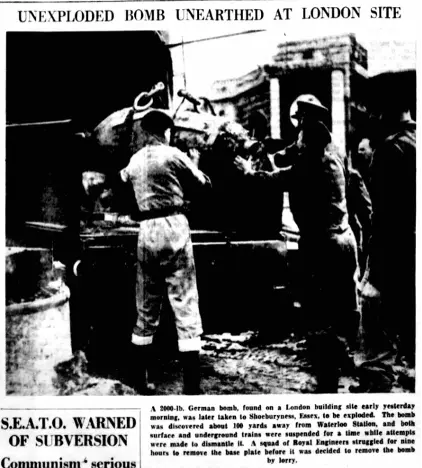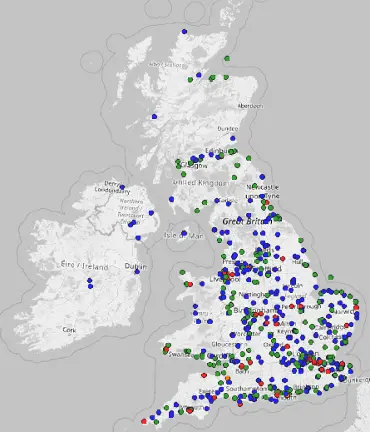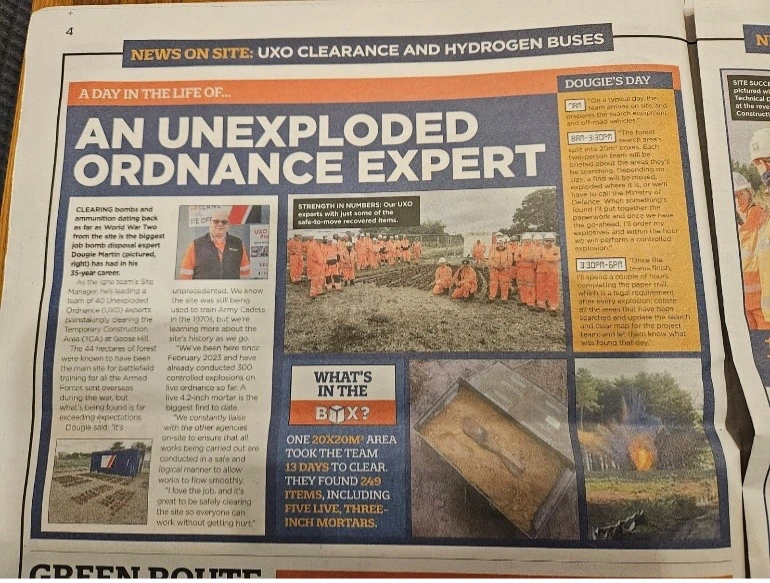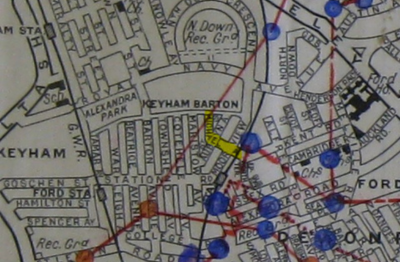UXO in the Media
Unexploded ordnance (UXO) isn’t necessarily a common topic for discussion. Where the subject does come up in popular media, the focus is usually on large-scale contamination from recent conflicts or a fictionalised, imagined representation of the threat – think The Hurt Locker!
However, the UK’s contamination from legacy ordnance does show up on our news feeds surprisingly regularly - and even on our TV screens. When the subject comes up, it’s always a timely reminder that these dangers do still lurk so close to home.
By referencing some of the media’s coverage of UXO in the UK, we hope this article serves as an introduction to the dangers, (and prevalence) of UXO – and why the threat should be taken seriously by anyone involved in intrusive construction or infrastructure works across Britain.
By Emily Damerell: Research Manager, Igne
UXO in Popular Culture
Speaking as a researcher for Igne, when I am asked to describe my job, three films always come up in conversation! The shed full of weapons, munitions and the huge sea mine in Hot Fuzz, the sea mines in Finding Nemo, and the afore referenced entire dubious plot of The Hurt Locker!
While the accuracy of these depictions is certainly questionable, showing the presence of UXO in films and media, either purposefully or inadvertently, raises awareness about their dangers and I’m here for that.
As well as these modern portrayals, historical films, such as those found in the British Pathé archives, document bomb disposal efforts and highlight the ongoing relevance of UXO safety from right after the war up to today.
UXO in the News
Last week, my work life and my Spotify Daily Mix collided as a news source shared that Dua Lipa had a UXO risk assessment undertaken for some home renovations. A wise move considering the location of her house in a heavily bombed part of London.
It’s literally my job to know that over 200 discoveries of UXO have been reported in the news this year alone. Whilst most stories may go unnoticed by many people, larger UXO finds, such as the bomb recently found in Plymouth, typically receive more press coverage and therefore more attention.
The larger the item, the more significant the disruption and the greater the fear they cause within local communities – and so the more the media fans the flames with highly visible national coverage.
The Plymouth bomb required an intricate and skilful operation from authorities and the army, highlighting the ongoing risks and complexities associated with UXO.
Smaller UXO finds attract local press attention and community interest. The UK's enduring fascination with its wartime history and the connection to these explosive remnants underscores their significance in British identity and culture.
Public engagement with news about UXO finds helps raise awareness of the lingering dangers and serves as a poignant reminder of the past. And it makes my role easier when I have to evidence why risk assessments really are critical!
Notable Media Coverage of British Bomb Finds
- Plymouth: a 500kg German bomb was discovered in a residential garden. It led to one of the largest evacuations since WWII, involving over 100 personnel and the relocation of more than 10,000 residents. Sky news invited my explosive ordnance disposal colleagues into the studio to provide live coverage of the disposal operations.
- Exeter: contractors working near Exeter University unearthed a 1,000kg German bomb, which when disposed of, caused damage to nearby buildings. Many followed this story with acute interest as it led to a significant legal ruling about war-related insurance claims.
- Off Cromer’s Coast: crab potting vessel Galwad-Y-Mor was hauling pots when the crabbing gear disturbed a 250kg unexploded WWII bomb. It detonated on the seabed below the boat causing a shock wave that hit the boat resulting in significant injuries to five of the seven crew and major damage to the vessel’s hull and machinery.
- St James Park, London: a WWII grenade found by a gardener resulted in a safety cordon and a controlled explosion by bomb disposal officers.
Also, have you heard about the significant dangers presented by the SS Montgomery shipwreck within the Thames Estuary? The concern about this major risk make regular appearances across our news sources and even in fictional drama: “The infamous SS Richard Montgomery 'bomb ship' off the coast of Sheppey could detonate and cause a huge tsunami, a new Sky drama has predicted.”
Older Newspaper Articles
The presence of UXO has been a consistent topic in UK newspapers from immediately post-war up to the present day. Historical accounts provide a window into just how long communities have dealt with these dangerous remnants.

Igne UXO Press Articles Map
Igne maintains a comprehensive database and map showing publicised UXO finds across the UK. This map categorises UXO by origin, with red for German, blue for British or Allied, and green for unspecified origins. The extensive spread of finds, predominantly of British or Allied origin, illustrates the widespread impact of wartime activities.
A sample of recent data is presented on this map.

UXO Experts in the News
Igne's UXO experts have been featured in news reports, providing valuable insights and accurate information about UXO discoveries. Ensuring that expert voices, from companies like ours and from our industry peers, are heard helps prevent sensationalist reporting and promotes public safety.


The Value of the Media Raising Awareness of UXO Risk
News coverage of UXO discoveries is crucial for increasing public awareness of these dangers. Many munitions are discovered by members of the public, emphasising the need for proper handling procedures to prevent accidents. Notable examples include:
- White Phosphorus on Beaches: incidents of children discovering dangerous military debris highlight the ongoing risks in seemingly safe environments.
- UXO Handed into Police Stations: evacuations are often necessary when UXO is mistakenly brought to police stations, as seen in Jersey and Bangor recently.
- Donations to Charity Shops: instances of artillery shells being donated to charity shops underscore the need for public education on UXO safety.
- Magnet Fishing Finds: the popularity of magnet fishing has led to the discovery of numerous WWII-era munitions, raising awareness about the potential dangers hidden in waterways.
UXO and Social Media
- Local Groups: social media platforms, including Facebook and X (Twitter), often feature discussions and updates about local UXO finds. However, misinformation can spread, highlighting the importance of accurate information from reliable sources.
- News Updates: UXO companies and construction firms share UXO news to raise awareness and encourage informed discussions. Public posts and videos of UXO incidents garner significant attention, showcasing the widespread interest in these events.
- Videos: the rise in popularity of TikTok has amplified the visibility of UXO discoveries, with videos of controlled detonations and safety operations reaching wide audiences. While this can raise awareness, it also underscores the need for careful information dissemination to avoid spreading misinformation. We have seen viral TikTok accounts for magnet fishing, which can show unsafe handling and removal of UXO.
Publicising the Impact of UXO Risk on Local Communities
The impact of UXO discoveries varies based on location and type of the find. In rural or coastal areas, UXO can often be defused or destroyed in-situ with minimal risk to the public. However, in urban areas, large-scale evacuations and complex removal operations are often necessary, causing significant disruption.
The incident in Plymouth this year, for example, required extensive road closures, evacuations, and a coordinated effort to safely transport and detonate the bomb at sea. The operation involved over 10,000 residents and numerous emergency services, showcasing the wide-reaching impact of such discoveries.
Financial implications are also significant, as evacuations and project delays can result in loss of earnings and complex insurance claims. The Exeter incident, where an insurance company was not required to cover war-related damage, exemplifies these challenges.
The inclusion of the effects of these discoveries on a community brings the hazard and the danger to the forefront of what can otherwise be a sensationalist and exciting news story. It is always important to remember that, as interesting as a UXO discovery can be, there will always be an inherent danger and threat to those close by.
As UXO discoveries continue to capture public attention, it’s vital for companies like Igne and our industry peers to reinforce safe procedures when working on former military land or intrusively constructing on unexplored areas.
By promoting accurate information and sharing expert advice, we want to ensure public safety and maintain awareness about the enduring impact of military history on modern UK life.
If you’re planning any form of construction activities anywhere in the UK, your first critical task in considering UXO is to request a risk assessment, it would be my pleasure to assist you with this. Please contact my team and me for immediate assistance.
Other articles of interest

How Igne’s UXO risk assessments keep clients on time and budget
Igne’s research team create detailed UXO risk assessments so clients can determine the risk level of their sites.

Expert Opinion for the BBC
As news coverage of the Plymouth bomb find continues, Igne's Explosive Ordnance Disposal (EOD) and research experts have been cited by the BBC and regional press, and have provided insight into what the Army may do next, and how insurers may involve an 'occasioned by war' clause to avoid paying out for any potential damage.


